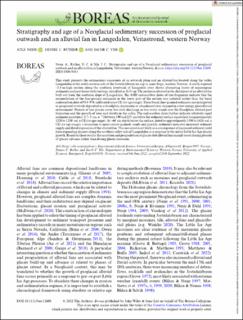| dc.description.abstract | This study presents the sedimentary succession of an outwash plain and an alluvial fan located along the valley Langedalen at the south-eastern side of the Jostedalsbreen ice cap in inner Sogn, western Norway. A newly exposed ~2.8-m-high section along the southern riverbank of Langedøla river shows alternating layers of minerogenic sediments and peat layers with tree logs, identified as Salix sp. The section is situated in the distal part of an alluvial fan built out from the southern slope of Langedalen. Six AMS radiocarbon dates of tree fragments indicate that the accumulation of the fine-grained sediments in the lower part of the section was initiated earlier than the basal radiocarbon date of 914–976 calibrated years CE (1σ age range). These basal, fine-grained sediments are interpreted as proglacial outwash deposited in a floodplain depression or abandoned river channel in a low-energy glaciofluvial environment. Periods of low glacier cover, low river discharge or low-water stands over the floodplain allowed peat formation and the growth of trees and shrubs in the valley. The radiocarbon dates further indicate relatively rapid sediment accretion (~2.7–3 cm a−1) between 190 and 125 cm below the sediment surface, equivalent to approximately 1220 to 1250 cal. a CE (1σ age range). At ~60 cm depth below the surface, dated to approximately 1590 to 1620 cal. a CE (1σ age range), a transition to more coarse-grained, sandy and gravelly sediments indicates increased sediment supply and distal expansion of the alluvial fan. This occurred most likely as a consequence of increased sediment yield from expanding glaciers along the southern valley side of Langedalen as a response to the initial Little Ice Age glacier growth. Based on these results, the accretion and progradation of glacier-fed alluvial fans mainly occur during periods of glacier advance rather than during glacier recession. | en_US |

